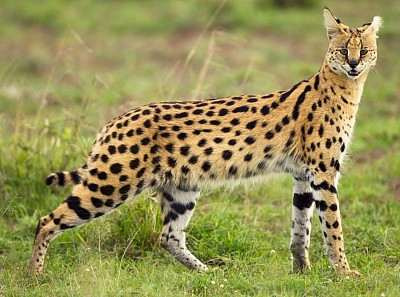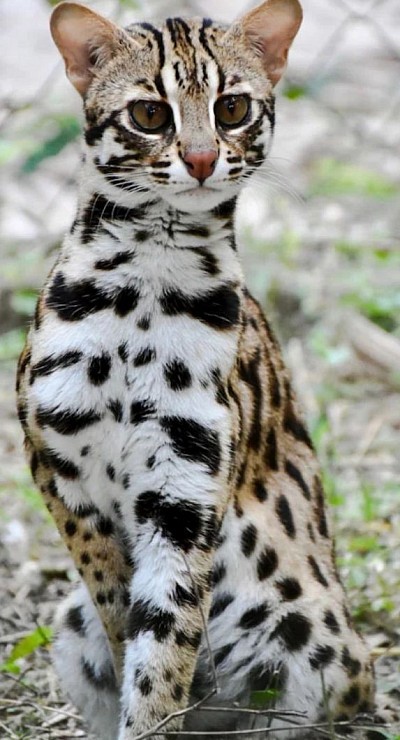Wild Cats
Wild Cats
Serval
Servals are elegantly spotted felines distinguished by their elongated bodies and notably large ears. Renowned for their exceptional auditory capabilities and diverse hunting techniques, they rank among the most proficient feline predators.
Weight: 9–20 kg
Size: Giant
Lifespan: 10–20 years
Breed Group: Wild cat
Curious to determine if your cat is a Serval? Explore Wisdom Panel’s DNA testing options.
Serval Traits
General Appearance: Servals are small, slender wild cats, with a maximum weight of approximately 40 pounds.
Coat and Colouring: Often referred to as the “giraffe cat,” the Serval features a pale yellow coat embellished with an exquisite pattern of black spots and stripes. Their underbellies are white, and their black ears bear distinctive white spots on the reverse side.
Distinctive Physical Traits: Relative to their body size, Servals possess the largest ears and longest legs among all cats. They have small heads, elongated necks, slender bodies, and short tails.
Serval Temperament
Servals are solitary by nature, typically interacting with others only during mating or when females are rearing their young. When kept as pets, they can form bonds with humans and may become affectionate if socialised from an early age. However, they tend to be wary of strangers.
Territorial marking through urine is common; even with litterbox training, this behaviour is difficult to eliminate. Their vocalisations include prolonged yowls, sharp cries, purrs, and growls. As with all wild cats, captive Servals require spacious outdoor enclosures that allow for free movement. They are capable of leaping up to nine feet and can dig beneath fences, so enclosures must have secure tops and sides extending several feet underground.
Serval History
Native exclusively to Africa, Servals primarily inhabit the savannas of central and southern regions. They thrive in grassy areas adjacent to streams and rivers, environments that facilitate their remarkable hunting abilities.
The term “Serval” derives from the Portuguese word meaning “deerlike wolf.” Servals have been depicted in ancient Egyptian art and were historically presented as exotic gifts by Egyptian rulers. Additionally, they appeared as a heraldic symbol on the Italian Tomasi family coat of arms in the 1800s. Although often translated as “The Leopard,” the renowned historical novel Il Gattopardo by Giuseppe Tomasi di Lampedusa incorporates Servals within its themes.
Human fascination with keeping wild animals as companions led breeder Suzi Wood to cross Servals with domestic cats in 1986, creating the Savannah breed. This hybrid exhibits the Serval’s distinctive spotted coat while maintaining the temperament of a domestic cat.
In certain jurisdictions, ownership of Servals is permitted. While these cats may be several generations removed from their wild African ancestors, they remain subject to regulations governing exotic animal ownership.
Serval Care
Nutrition: Servals require a diverse diet consisting of birds, rodents, insects, frogs, and reptiles.
Grooming: Their short coat demands minimal grooming. If accustomed to handling, nail trimming is advisable to reduce the risk of scratches.
Health: Servals necessitate vaccinations and preventive care similar to domestic cats, but must be treated by veterinarians specialised and licensed in exotic animal medicine.
Wild Cats
Asian Leopard Cat
The Asian Leopard Cat is among the most widely distributed carnivores across Asia. Renowned for its striking spotted coat, this species has also played a significant role in the development of the Bengal cat breed.
Weight: 4–7 kg
Size: Medium
Lifespan: 10–13 years
Breed Group: Wild cat
If you are interested in determining whether your cat has Asian Leopard Cat ancestry, consider using Wisdom Panel’s DNA test.
Asian Leopard Cat Traits
General Appearance: Asian Leopard Cats are comparable in size to large domestic cats, though their size and coloration vary significantly depending on their geographic location.
Coat and Coloration: The coat color ranges from yellow hues in southern populations to gray tones in northern regions. Their sides display black rosettes, while solid spots appear on their legs and tails. Typically, four black stripes extend from the forehead to the nape of the neck. Coat length varies with environment; northern populations exhibit longer, thicker fur.
Distinctive Physical Traits: These cats possess a small head, a short narrow muzzle, long rounded ears, and eyes that range from golden-brown to grayish.
Asian Leopard Cat Temperament
Primarily solitary and nocturnal, Asian Leopard Cats generally hunt at night and rest during the day in dens located within hollow trees. Although males and females may occasionally raise their young together, they predominantly lead solitary lives.
They are adept climbers and capable swimmers, although they tend to avoid swimming. In captivity, they require spacious outdoor enclosures that allow for ample roaming.
Asian Leopard Cat History
The Asian Leopard Cat is the most prevalent wild cat species in Asia, boasting the largest geographic range of any feline. Their habitat spans eastern Afghanistan, northern Pakistan, northern and coastal India, Myanmar, Laos, Thailand, Indonesia, Malaysia, Vietnam, Sumatra, Java, Bali, Borneo, Nepal, Korea, Cambodia, parts of the Philippines, Eastern China, and Taiwan.
These cats adapt to diverse environments and elevations, including tropical and pine forests, jungles, mountainous areas, and semi-deserts. They often remain undisturbed by human presence and frequently inhabit regions near villages, where they assist locals by controlling rodent populations.
In 1963, breeder Jean S. Mill crossed domestic cats with the Asian Leopard Cat to create the Bengal hybrid breed. Bengals are fully domesticated and suitable as pets. While Asian Leopard Cats can be kept as pets in certain jurisdictions, they require permits and are subject to stringent regulations.
Other wild cats within the Leopard Cat group include the Asian Golden Cat, Bay Cat, Black-footed Cat, Fishing Cat, Flat-headed Cat, Jungle Cat, and Pallas Cat. The Pallas Cat inhabits cold, arid regions of central Asia, whereas other species prefer wetland habitats.
Asian Leopard Cat Care
Nutrition: Their diet primarily consists of rodents, supplemented by plant matter. They may also opportunistically prey on poultry from farms.
Grooming: Asian Leopard Cats groom themselves regularly to maintain cleanliness and to mask their scent, aiding in stealth while hunting.
Health: These cats are susceptible to several diseases common among domestic cats, including Feline Immunodeficiency Virus. Captive individuals require vaccinations similar to those administered to domestic cats. It is crucial to consult a veterinarian experienced and licensed in exotic animal care to address their specific health needs.



